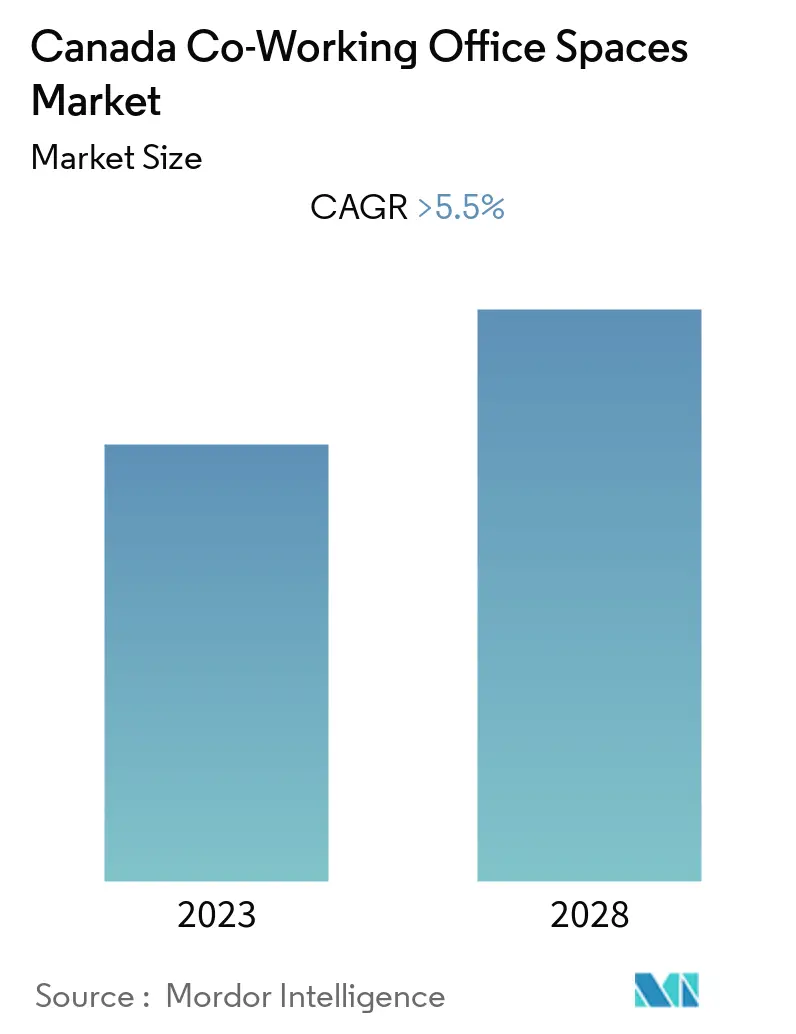Market Size of Canada Co-Working Office Spaces Industry

| Study Period | 2019 - 2028 |
| Base Year For Estimation | 2021 |
| Forecast Data Period | 2024 - 2028 |
| Historical Data Period | 2019 - 2020 |
| CAGR | > 5.50 % |
| Market Concentration | Low |
Major Players
*Disclaimer: Major Players sorted in no particular order |
Need a report that reflects how COVID-19 has impacted this market and its growth?
Canada Co-working Office Spaces Market Analysis
The Canadian co-working office spaces market is expected to record a CAGR of more than 5.5% during the forecast period (2022 -2027). In Canada, the COVID-19 pandemic impacted the co-working office space market. Due to the lockdown restrictions, the companies lost 75% of their customers. People are returning to co-working spaces more than a year and a half later. These changes are proving to be beneficial to co-working spaces, which were growing increasingly popular before the outbreak impacted their economic models. As COVID-19 cases decrease, people seek new ways to work, socialize, and get out after more than a year at home.
The co-working trend has evolved into a transformative force in the Canadian corporate scene. New work patterns are in demand, and many flexible office operators are gaining a foothold in the lease market. Co-working real estate alternatives are reshaping other key markets in Canada. Since 2017, the flexible footprints of Calgary, Ottawa, and Vancouver have grown by more than 80%. The Waterloo region competed with Toronto (1.8%) in terms of market penetration of co-working space operations (with co-working accounting for 1.4% of total office supply). Suburban growth has outperformed downtown growth in Edmonton and Waterloo region. The suburban co-working space market in Vancouver grew by 83%.
There are currently 617 co-working spaces in Canada, including locations run by major corporations such as Staples. Several large corporations have already stated their intentions, setting the tone for the discourse in North America. JPMorgan Chase asked all of its workers to return to work. In the meantime, Ottawa-based e-commerce company Shopify abandoned its headquarters in favor of a remote-only workforce. However, as vaccine protection improves and the debate over the future of work heats up, some businesses see an opportunity to strike a middle ground by adopting a more "flexible" approach to the workplace through co-working.
Canada Co-working Office Spaces Industry Segmentation
Co-working spaces refer to working arrangements in which people from different teams and companies come together to work in a single shared space. A co-working space is characterized by shared facilities, services, and tools. Sharing infrastructure in this way helps spread the cost of running an office across members. The Canadian co-working spaces market size indicates the country's revenue generated by co-working spaces companies.
The report covers a complete background analysis of the market, which includes an assessment of the sector and contribution of the sector to the economy, market overview, market size estimation for key segments, key developments, and emerging trends in the market segments, market dynamics, and key statistics. The report also covers the impact of COVID-19 on the market.
The Canadian co-working office spaces market is segmented by end user, type, application, and key city. For each segment, the market sizing and forecast have been done on the basis of value (USD billion).
| By End User | |
| Personal User | |
| Small Scale Company | |
| Large Scale Company | |
| Other End Users |
| By Type | |
| Flexible Managed Office | |
| Serviced Office |
| By Application | |
| Information Technology (IT and ITES) | |
| Legal Services | |
| BFSI (Banking, Financial Services, and Insurance) | |
| Consulting | |
| Other Services |
| By Key City | |
| Vancouver | |
| Calgary | |
| Ottawa | |
| Toronto |
Canada Co-Working Office Spaces Market Size Summary
The Canadian co-working office spaces market is projected to experience significant growth in the coming years. This is largely due to the increasing demand for flexible work arrangements, particularly in the wake of the COVID-19 pandemic. Prior to the outbreak, co-working spaces were already gaining popularity, and this trend has continued as restrictions ease and more people seek out new ways to work and socialize. The market is also being shaped by the growth of flexible office operators in the lease market, and co-working real estate alternatives are reshaping key markets across Canada. The future of the co-working industry in Canada looks promising, with demand for flexible workspace options and the use of technology and automation expected to drive growth. The emphasis on sustainability and green initiatives, as well as the desire for community and collaboration, will also play a crucial role in the development of the market. As more people work remotely or as freelancers, co-working spaces are set to provide a valuable solution to the need for flexible, affordable workspace options. The market is dominated by major players like IWG and WeWork, but also features hundreds of single-site operators across the country.
Explore MoreCanada Co-Working Office Spaces Market Size - Table of Contents
-
1. Market Insights and Dynamics
-
1.1 Market Overview
-
1.2 Market Dynamics
-
1.2.1 Drivers
-
1.2.2 Restraints
-
1.2.3 Opportunities
-
-
1.3 Technological Trends
-
1.4 Industry Value Chain Analysis
-
1.5 Government Regulations and Initiatives
-
1.6 Insights on Co-working Startups in Canada
-
1.7 Industry Attractiveness - Porter's Five Forces Analysis
-
1.8 Impact of COVID-19 on the Market
-
-
2. Market Segmentation
-
2.1 By End User
-
2.1.1 Personal User
-
2.1.2 Small Scale Company
-
2.1.3 Large Scale Company
-
2.1.4 Other End Users
-
-
2.2 By Type
-
2.2.1 Flexible Managed Office
-
2.2.2 Serviced Office
-
-
2.3 By Application
-
2.3.1 Information Technology (IT and ITES)
-
2.3.2 Legal Services
-
2.3.3 BFSI (Banking, Financial Services, and Insurance)
-
2.3.4 Consulting
-
2.3.5 Other Services
-
-
2.4 By Key City
-
2.4.1 Vancouver
-
2.4.2 Calgary
-
2.4.3 Ottawa
-
2.4.4 Toronto
-
-
Canada Co-Working Office Spaces Market Size FAQs
What is the current Canada Co-Working Office Spaces Market size?
The Canada Co-Working Office Spaces Market is projected to register a CAGR of greater than 5.5% during the forecast period (2023-2028).
Who are the key players in Canada Co-Working Office Spaces Market?
Lab T.O., District 28, La Halte 24/7, L’ Atelier Vancouver and BNKR are the major companies operating in the Canada Co-Working Office Spaces Market.
